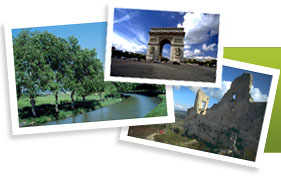Situated in the heart of the Suisse Normande region of Normandy, the small village of Clécy provides a perfect haven for the active. Living up to its name, the Suisse Normande provides a plethora of sports that take you into the depths of the beautiful rocky scenery. Rock climbing, walking, canoeing and horse riding are just some of the activities you can enjoy. Nearby Sugar Loaf Mountain provides a challenge for the most enthusiastic climber.
You may also visit this beautiful region of France to tour the Battlefields of Normandy. Clecy is a great stop over point when travelling through the region. Situated a bit further out, 10km south of Thury-Harcout, a village approximately 25-30km south of Caen, Clecy sits on a hill overlooking the River Orne. With a superb model railway for the children and a great village charm, Clecy also serves as a perfect base to see the surrounding areas.
Pegasus Bridge
An important landmark in history, the Pegasus Bridge straddles the River Orne and is one of two bridges captured by Allied troops that was key to the success of the D-day landings. Situated 5km south of Ouistreham, the bridge is connected a number of heart-rending stories of the troops that fought here.
Falaise
The nearby town of Falaise is also worth visiting. The birthplace of William the Conqueror, this town is steeped in history and lays only 25km away.
Further Afield
Caen
Another city that was almost completely destroyed in the struggle of the D-Day invasions of 1944, here you will not only find tributes to both World Wars such as the Caen Memorial but a plethora of other cultural sites and activites. Although now quite an industrial city, Caen's central feature is a ring of ramparts that in past times protected a castle. Within these walls lie the Exchequer, the Beaux Arts Museum and the Museum of Normandy. Here you will not only get to appreciate superb collections of fine art but learn about the history of the city. The Abbaye aux Hommes and Abbatiale Ste-Etienne, Abbaye aux Dames and the Bassin St-Pierre are also sites in Caen worth visiting.
Bayeux
Situated around 40 km from Clécy, the medieval town of Bayeux has the most beautiful architecture, superb museums and lovely ‘Normandine’ restaurants.
Bayeux Tapestry
The Centre Guillaume le Conquérant is located on the rue de Nesmond. The famous Bayeux tapestry recounts, simply but with a wealth of detail, how and why William the Conqueror achieved the conquest of England in 1066. The tapestry is a magnificent 70 metres long and its colour and vibrant scenes of medieval life are quite something. Thought to have been embroidered by Nuns in England and commissioned by William’s half brother, the tapestry is truly one of its kind.
Cathedral of Notre Dame
Cathédral Notre Dame, a short distance away from the Bayeux Tapestry following the rue de Nesmond, is one of the oldest buildings in Bayeux. The Notre Dame Cathedral was once the original home to the Bayeux tapestry. The 11th century cathedral boasts some beautiful original architecture alongside the later more gothic additions. The crypt is one of the few remaining Romanesque structures with beautiful frescoes lining the walls. A 12th century nave holds some stunningly carved choir stalls and an 18th century dome, that tops the crossing tower, is a fine example of the combination of architecture and styles used from across the centuries. This cathedral is a particularly beautiful building that has been amazingly preserved throughout France's turbulent history.
Memorial Museum of the 1944 Bataille de Normandie
Just a few minutes from the D-Day landing beaches, this museum retraces the 77 days of fighting which opposed Allied forces and the Germany army on the soil of Normandy in the aftermath of 6th June 1944. The museum exhibits documents and film of the Normandy landings and there are life-sized models and military props to give people a better understanding of the events that surrounded those troubled days. Opposite the Memorial Museum lies the British War cemetery from the ‘1944 Bataille de Normandie’ where there are 6000 British soldiers buried.
Arromanches
Once a peaceful fishing village, Arromanches became one of the main areas of Normandy beach used for the Allied landings. Famous for its artificial Mulberry harbours, Arromanches is an evocative place to visit for those exploring the battlefields, beaches and cemeteries of Normandy.
In Arromanches you will find the Musée de Débarquement, the D-day Landing Museum. "The permanent Landing exhibition" displayed here was created in 1953. Its exhibits include personal belongings, relief maps and working models. Arromanches is also home to a unique cinema. The Arromanches 360 was created upon the initiative of the Lower Normandy Regional Council for the Fiftieth Anniversary of the Landings. The film, Le prix de la liberté (the price of freedom) is an outstanding film and is shown on 9 screens in a circular viewing room, an impressive 360-degree Circorama, this is an experience not to be missed. The cinema itself is one of only three in France and the film is a great and dramatic tribute to the men who fought and lost their lives.
D-Day landing beaches of Normandy
From the area surrounding Arromanches you can travel west down the coast and view other famous D-Day landing sites. The whole stretch of this Côte de Nacre was used for the Allied landings in June 1944. The Canadian and the British troops used Sword Beach, Juno Beach and Gold Beach whilst the Americans used Omaha and Utah. Today you can view this surprisingly beautiful area, its museums, tributes and landing sites of the Allied troops.
Omaha Beach
Omaha Beach holds many memories both painful and victorious. A contrast to its sister site Utah, where there were 197 deaths on that fateful day, Omaha was a completely different story. Low cloud prevented bombers launching a successful raid, officers signalled to release amphibious tanks too early and they consequently sunk with their occupants, and in total over 2,500 men died and three times that many were wounded before the day was up. Hence it was nicknamed ‘Bloody Omaha’. On your visit to this area you will not only get a better understanding and sympathy for the events that occurred here but you will appreciate the ironic beauty of the area. In amongst the sadness and memories of the past is present day Omaha. Today Omaha Beach and its crystal clear waters attract sunbathers and swimmers both young and old and the adjacent landscape is dotted with holiday cottages. A visit to this area is one that you will never forget and enables you to pay your respects to all those that served and endured those horrific times of battle.


